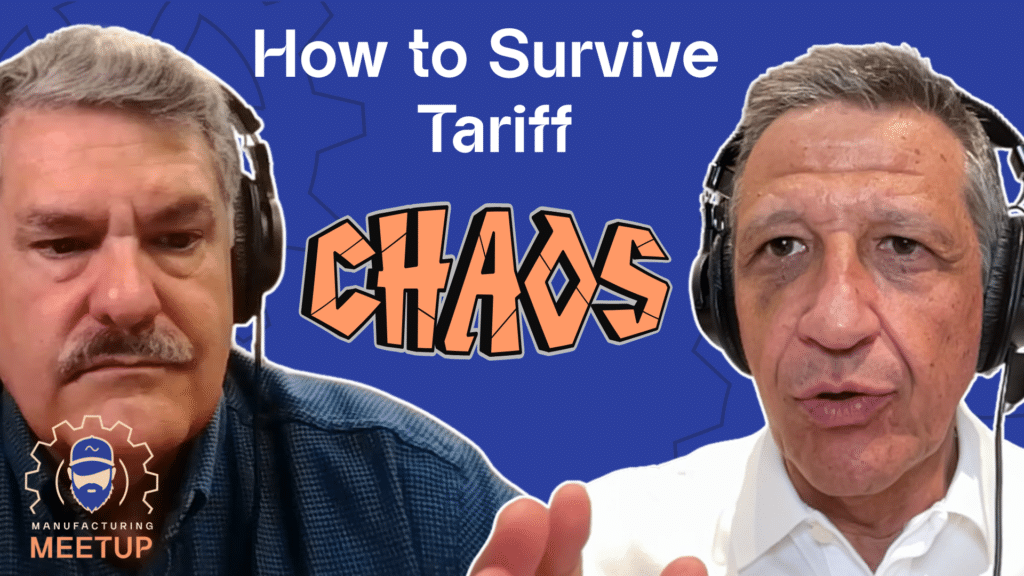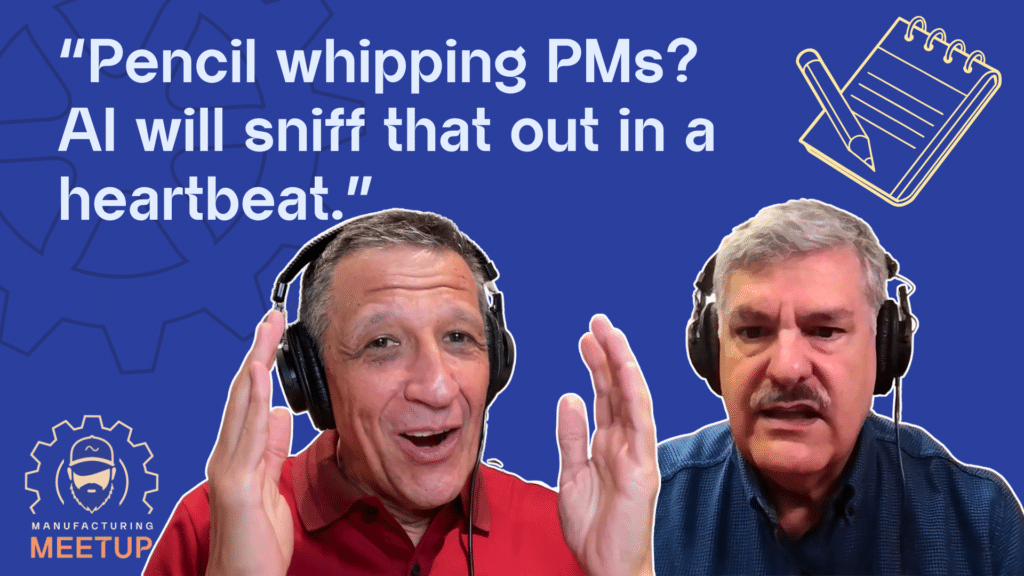Manufacturing: Perception vs. Reality
It’s the ultimate paradox: Americans love the idea of bringing back more manufacturing, but they’re not interested in the jobs that come with it. Currently, an estimated 500,000 manufacturing roles sit empty, and projections show potentially 2.5 million unfilled jobs in five years. It’s time for Ed and Alvaro to step in and explain what’s really happening on today’s factory floors.
Forget the grim, dirty workplaces of yesterday—cobots, AI, and smart technology are transforming manufacturing careers. But it’s not perfect. Using concepts like Maslow’s hierarchy of needs, the guys show how factories have improved basic safety but must reach higher for true worker engagement. Through real-world examples, they debunk persistent myths, highlight surprising safety improvements, and serve up practical ideas to bridge the perception gap. Whether you’re already in manufacturing or just curious about its evolution, this candid conversation reveals the genuine opportunities hiding behind outdated stereotypes.
To keep the conversation going:
Email us: mmu@augury.com
Find us on The Endpoint: endpoint.augury.com
Download the full podcast here:
Apple
Spotify
Amazon Music
iHeart Radio
YouTube Music (formerly Google Play)
Full Transcript
Ed Ballina (00:00)
Well, hello there team, Manufacturing Meet Up friends and neighbors. I’m Ed Ballina.
Alvaro Cuba (00:06)
Hello guys, Alvaro Cuba here.
Ed Ballina (00:09)
No surprise, we want to welcome you to the Manufacturing Meet Up podcast. This is a show where we kick back, we talk about our shop floor experiences, ⁓ sometimes drown our sorrows in a cup of coffee, or a slightly stronger adult beverage. So, welcome to MMU.
Well, there’s a lot to talk about for sure, right, Alvaro? We just had a conversation about tariffs ⁓ and there’s questions about bringing manufacturing back to the United States. ⁓ There’s one reality. We are right now struggling to find enough people to fill the jobs we have today.
Alvaro Cuba (00:41)
Yeah. Actually, the last figure from the Labor Department of Labor is right now half a million is the gap, a million people. And the projection in five years is two and a half million. So if we don’t do something, our biggest problem is not going to be tariffs or COVID, it’s going to be… people to run our lines. And that in spite of all the technology that has already gone in. So that question about, ⁓ am I going to lose my job because of technology? No, ⁓ we need more hands. And I think you checked another very impactful survey.
Ed Ballina (01:54)
Well, I had the same data from you, but from a percentage standpoint, said 47 % of manufacturing jobs are currently unfilled. The market suggests that it’s well over a million jobs, and we’ve seen the stats come out that reiterate that. So we wanted to try and delve into this. We have discussed it in different podcasts, but we really believe that we have a perception problem with manufacturing.
I mean, Alvaro and I have both spent our lives in this field and we can tell you it’s amazingly rewarding, but we recognize that the perception out there is a little bit different, right? There are folks who still think we’re back to the, you know, we’re still in the dark ages of manufacturing, you know, kind of the sweatshop, dim, grim, everybody with, you know, mud caked on their faces, missing digits. And listen, I’m here to tell you that is not the case⁓ in today’s manufacturing environment. But there’s data that Alvaro was referencing that says exactly that. So we are in complete agreement as Americans that we want manufacturing back in the United States. In fact, 80 % of us agree that manufacturing in the United States is a good thing for us as people. It’s a good thing for us as a country. But this reminds me a little bit of the discussion that people would have about landfills.
We all agree we wanted to reduce landfill space and all that, but the truth of the matter is we still have waste that we wind up landfilling. So everybody agrees that we need enough landfills for that. As long as it is not in my backyard, right? It was called NIMBY. They even came up with a phrase for it, not in my backyard. It almost feels the same with manufacturing. So while 80 % of Americans agree manufacturing for the US is important for themselves personally, only 27 % want to work in plants.
And let me tell you, that is a huge opportunity for us. And as Alvaro mentioned, the gap is only going to get worse. And there’s a number of reasons for this, right? Again, that perception still remains. There’s a lot of competition from service jobs. And service jobs, frankly, in many cases, offer you more balance because you can do them somewhat remotely. ⁓ You’re not at the whim of the machinery. If you work in a manufacturing plant that is running very poorly, low efficiency and low predictability. I’ve used the term Hotel California. You can check in, but you don’t know when you’re leaving, because you leave when the machine’s up and running. And that is a challenge for a lot of people that obviously have lives outside of work. So common misconceptions about manufacturing, low pay, dangerous conditions, lack of career growth. Folks, we’re here to tell you that is not the case. And it really hasn’t been the case in quite some time.
So join us in manufacturing. We need you. And you can have an amazing career. After all that pleading, I’m turning it back to Alvaro.
Alvaro Cuba (04:58)
⁓ I’m hearing your pleading and I’m thinking maybe I can go, I should go back to work in a line. You have to come with me, my friend. Amigo, you come with me.
Ed Ballina (05:08)
I think this was already been recorded in the Lucy ⁓ and Desi ⁓ clip of her and Ethel in the chocolate factory. That’d be like you and me.
Alvaro Cuba (05:27)
Yes. my God. Yeah. I’ll be doing this.
Ed Ballina (05:32)
I’ll be eating them.
Alvaro Cuba (05:35)
I suspected that much. Yeah, it’s the perception and Ed talked about it. It’s also the competition, manufacturing jobs were 44 % of all private sector non-farm jobs in middle of last century. 44%. Now it’s 10%. Service is the one that is 80- 85 % today. So the competition is not anymore between manufacturing or plants, it’s outside manufacturing. So we need to be thinking on the perception that Ed was describing, no, low tech and overwork and all the other things that Ed mentioned, which were true.
And unfortunately, in a minor percentage, it’s still true in some places to be totally transparent. But the majority of the manufacturing, the big plants in America is changing dramatically. So we wanted to tackle this because you heard what people are saying, no? We want the manufacturing.
There is a gap in manufacturing, but we don’t have enough people that want to come to manufacturing. So we want to change the perception. And I think that’s a job for all of us, Everyone that is listening to us have to jump to it and help, not only doing things in your plants to change the reality, but helping to publicize them.
So what do we do with that perception? First, as Ed was saying, there has been progress made. We cannot deny that. And the numbers are there. Things like safety have improved dramatically. Total incident rate, I remember, averaged in 2 to 2.5. Now it’s 0.5.
Many companies are going to 0.3, 0.2. So dramatic improvement. OSHA, same thing, big, big improvements. Ergonomics, now there has been a lot of automation in the plant. So we have the cobots that help doing all the heavy lifting. So ergonomics, big change in representation.
We talked in a previous episode when we were talking about women in manufacturing, about the numbers. Progress has been made. Still, we need to continue on that area. I have seen plants run completely, 100 % by women and run beautifully. So automation, cobots, now AI, even all the…TPM, CI, 5S, lean, and all that has been doing tremendous thing for manufacturing. Lines that I seen with my previous eyes stopping every minute, then move after one, two years to stop every four hours.
Imagine the life of the operator that comes from intervening the machine every minute to now it runs four hours and I have time to think, I have time to work, I have to operate. So between that improvement in process and now with technology accelerating that, we have a ⁓ big improvement from a people perspective. What do you think Ed?
Ed Ballina (09:54)
Yeah, the technology has been a huge enabler. One of the reasons why we can still have our GDP and produce more than ever before with a fourth in manufacturing workforce is because of technologies, productivity that’s gotten us here. And look, folks, there’s still a lot of progress that needs to be made. Alvaro and I, we’re trying to figure out what percent of the plants do we think are nice places to work and what percentage are challenging. ⁓
You know, it’s probably, you know, 50 % nice place to work, 30 % getting there and 20 % places where you’re like, oh my goodness, right? There were still some of those places here, but less and less all the time. And part of the reason, frankly, is because a lot of those are older facilities that have aging equipment that is really not productive anymore. But with that, I would also tell you, I have seen many examples of brownfield sites, right? That have had, you know, some you know, minor investment, but a lot of process and culture work that have absolutely kicked you know what. So we recently hosted the Augury Spotlight Awards and there was one facility that was relatively new and their performance was incredible. And I salivated at their pictures of their control room, right? But guess what? The one that got the highest praise was not a greenfield site. It was an existing facility where they really took on the approach of AI and predictive maintenance.
You know, brought the culture with them and they had phenomenal performance. So don’t feel bad if you’re in one of these older facilities. There’s still somewhat room for growth, arguably more room for growth and potential than the facility that got started up two years ago, because they got the latest WYSIWYG, right? This is your chance to, you know, translate an older facility into a very viable place. And look, there are regional, right, and company differences in how they approach modernization.
Typically, if you’re working in the north of the United States, you tend to be working in older facilities in the south, a little bit newer, a little bit newer in the west versus the east, but we are making great progress and really it is a wonderful experience. One technology example I was gonna share with you is one of the worst jobs we have in some of our facilities is warehousing, especially where they are single picking cases. People may throw two, 3000 cases a night.
That is hard work. Now there are companies are developing exoskeletons. I’ve actually seen them. They’re slick. You wear them for both your legs and your kind of upper torso and they help you lift up the cases so that you literally feels like you’re lifting ounces instead of pounds. And again, there are examples of that throughout that it’s making the work a lot more ergonomic. and approachable for all of us, which I think is important. Alvaro?
Alvaro Cuba (12:53)
Well, ⁓ we have talked about the progress that we made, but when we were talking with Ed, ⁓ we are conscious that more job needs to be done to continue going on a best place to work for our folks in manufacturing. Some examples is, and Ed alluded to that, is culture change.
No, we are doing a fairly good job on starting to put process with TPM or the likes, plus artificial intelligence, now accelerating that. But the people part, the cultural part, walk the talk, empower, flexibility. We have done not much in flexibility in manufacturing.
No, it continues to be the 7 to 3 and 3 to 11 and 11 to 7 and not a lot flexibility. I have seen some initial examples. Note when the line starts running well and you have a couple of people in the line and one can start taking the time, then you can use the other person can have some flexibility to go and visit suppliers or go to the market. So still flexibility is something. ⁓ Innovation is another area. In our discussion, you were mentioning the pyramid, the famous pyramid, but I’ll leave it to you Ed.
Ed Ballina (14:50)
So I have not been to Giza. I haven’t seen the real pyramids. I’m just talking about. ⁓ That’s cool. I have never been to Egypt. I definitely I came close to going to Tulum and I didn’t make it one time, but that’s on the bucket list. What we’re talking about is is the Maslow’s pyramid of hierarchy of human needs, right? It was work that was done. I’m not sure probably in the 60s or somewhere.
Alvaro Cuba (14:57)
seen the Mexican ones, but…And the Egyptians.
Ed Ballina (15:20)
⁓ that essentially says as human beings we are motivated right by different things at different times but the most basic at the bottom of the pyramid says we have basic needs for personal safety, for food, for water, right and maybe even on the bottom there’s something about community or ⁓ know okay well as so once you fill those needs, right, where you’re not worrying about the cyber tooth tiger eating you and you’re gonna have food for today, you start looking at things that ⁓ provide more meaning to you. And you go up the pyramid, as you get to the top, at the very top of the pyramid in terms of motivation, something called self-actualization, where you are so evolved that you are essentially growing almost by yourself and acquiring new knowledge all the time. I aspire to that Nirvana moment. I’m really much lower in the pyramid, but if you apply the concept of you have to take care of basic needs, right, before you appeal to higher interests, I think we’ve done a reasonably good job of taking care of those basic Maslow needs, right? They’re almost called hygiene. Safety, right, personal safety you mentioned. I mean, the numbers are staggering, okay? When we had a notion of incident rate of two and a half, three.
Alvaro Cuba (16:31)
I agree with you.
Ed Ballina (16:40)
And we’re now down below 0.5. That means three or four times less people went home with missing fingers or cuts or abrasions, Massive. I think there’s enough of a weight structure that people can feed themselves, right? ⁓ But if you just take care of that, you end up with people that will work, but you’re not really capturing their innovation, their creativity, their ideas.
⁓ And we haven’t made a lot of progress. Alvaro calls it out perfectly. To me, one of the biggest issues we have in manufacturing is this whole work-life balance. Okay, because if you’re working in a factory that runs 24-7 and you’re running first shift and the second shift person calls off, there is a very good chance you may be forced to work half of the next shift to cover that person. So now you got a 12-hour shift.
The person that thought they were coming in at 11 is now coming in at eight o’clock. They come in early. And guess what? You missed your kids recital or their baseball game and you have no control. So this work-life balance thing is huge for all of us. One big part of that is childcare. How do you deal with that? Right? I mean, you know, working couples struggle with this all the time. And then some of the higher, you know, callings, if you will. How do you challenge me?
Listen, many of us, 50, 60 % of our job is rote. We do it all the time. We deal with this issue. We go on this conference call. It’s probably 30 or 40 % of our job that turns you on, that gets you excited, where you found a you know, WYSIWYG, you found a new way to do something, and it excites you because you can make an impact. We need to provide more those opportunities for people, right, for them to self-actualize and learn. ⁓ And one other thing, frankly, I know I’m going to…poking a bear on this one a little bit, but our compensation in some of these locations is wholly inadequate. I’ve been to locations where they’re paying a mechanic, right, ⁓ maybe twice as much as somebody that is working in a fast food joint is making, right, but huge responsibility, working weekends and holidays, and guess what, they can’t keep people. So in this, in some of these places, you have had to double the pay of some of these mechanics in order to get the quality and the quantity that you need. ⁓ We, I think, have lagged in terms of labor cost or compensation, and it’s one of the reasons why we find ourselves in the situation.
Alvaro Cuba (19:15)
And it’s not a one way road, no? So it’s not that we all do this and try to go up in the pyramid and provide these other things just to be good with the people. Yeah, of course we want to do that and that’s common sense. But when you start doing that, when you take care of…the child or you give the flexibility when the people feel cared, start becoming engaged, then they become more innovative. They become more willing. They become hands. I seen operators that took a plane and went to discuss with suppliers about changes in the machine. No, or operators that now train the new engineers that are coming on tools for the lines and things like that. So in an environment where there is not enough people and that we need to take advantage of everyone, you want the people to be ⁓ comfortable, happy, then they become innovative. They can do a lot more than what we normally ask them to do. And they are the ones who will come with the idea. I always remember, I was practicing many, many years ago. I was doing a practice and they were ⁓ every year doing an award, special award to the most innovative idea that saved the company huge amount of money.
The guys that normally won the competition were the operators because they knew the process, they knew the products, and there were no big things, but small things that multiply by many. So getting them not only the bodies, but their minds and their hearts, it makes a huge, huge difference.
Ed Ballina (21:32)
It is. The other piece I wanted to mention is our need to widen the net that we cast. And there are some companies, hopefully not many anymore, but there are a number of companies where there was always a glass ceiling when it came to advancing your career if you didn’t have a college degree.
It was like, okay, you’re an operator. Okay, we give you like four levels of operator, right? Pay for skill type stuff, which is nice, better than just a flat rate. But once you topped out, you were done. You were retired for life at that level. And my goodness, how wasteful that is. I’ve had operators that were rebuilding car engines on weekends. I could probably run around circles some of my mechanics, right? But if I wasn’t engaging them, right, to come up with creative solutions, and then provide some sort of career path. ⁓ To me, the best companies out there are those who recognize that a college degree does not guarantee capability and or knowledge. You may find.
Alvaro Cuba (22:35)
And then in the young generations, most of them, don’t care about the college.
Ed Ballina (22:42)
They don’t. They’re steering away from that.
Alvaro Cuba (22:44)
Yeah, they want something ⁓ engaging. ⁓ Now we have technology to attract them. And we were discussing about how much the technology can help to get to the higher levels of the pyramid, but at the same time to relate to the people of the new generations and help us to bring more people.
So that folks bring us to the last point for today, which is some ideas that you can think about. In essence, it’s a work for all of us. So this is just some thought starters, but we have a big problem. As we were saying at the beginning, ⁓ only 20 % wants to work in manufacturing. And we already have a gap, and that gap can multiply by five, even with all the technology and automation that we are throwing into the plants. Then we all need to come very creative on doing this. So the first is technology. That’s an obvious one. And right now, I would encourage all of you, if you haven’t done that, to jump to it. It’s OPEX, it’s not CAPEX. It’s not one year, it’s two, three weeks of work. And then the results is three months. ROIs are five times, six times. So it’s very little preventing to go in that. And with this technology comes insights comes guidance, ⁓ actions, and many things that help the people and put the technology in people’s hands. the other is training. The second is training. You can have the Twin Towers. You can have ⁓ AR. You can have the ChatGPT or the coach.
So there are many ways to train to make people more flexible that you can change. And that also helps them to learn new things. there is ⁓ some other ideas that you have a couple others to help us start this journey.
Ed Ballina (25:32)
Just a couple of thoughts, just reinforcing some of the stuff that we said before, this is the time you need to make the right investment in your people and the facilities, right? You got to make them attractive. You know, spend a few thousand dollars repinting the break area and putting in better vending machines, right? These things are important. What do your bathrooms look like? Okay, if your bathrooms are, and it just sounds so banal, but it is important, folks, right, to have clean bathrooms that are brightly lit and well taken care of. Now you’re going to the restroom, you feel like you’re in a jungle. And how far are these restrooms from the work areas? In some of our plants, you get a 15 minute break, it takes you 15 minutes to walk to the restroom or the cafeteria, right? So little things mean a lot to people and it’ll change the mentality of what we look like. ⁓ And we need to reshape this manufacturing organization for the new generation right? Alvaro has talked a lot about technology something as simple as making your your your process available on an app phone on an app on the phone right? We talk about balance if I have the old Google Glass and I’m sitting in my seat and somebody’s asking me for a problem on a labeler and I don’t have to drive into the plant I can coach them on how to do it without having to leave, you know, my house for the weekend
That’s worth something and those investments are really important to people. You’ve given them back time with their family, which is precious. And last, you know, we were talking on a previous episode about tariffs and, you know, the amount of, you know, disruption that’s creating. Really, don’t burn the furniture, okay? I don’t know how to say that. I think all of us in manufacturing know what that term means.
And ⁓ because the furniture you burn today might be the one that your college graduate was going to be using and decided, you know what, I’m out of here. I don’t like what’s happening here. So ⁓ let’s change it. Really, manufacturing is an amazing, amazing place to work. And it’s getting better and better all the time, folks. It really is.
Alvaro Cuba (27:44)
And pushing into that, ⁓ now you can put a tremendous improvement in your lines, spending very little, or even you don’t need to think on capex. You just pay as you go. No. So all those things ⁓ help. But at the end, ⁓ so as… We don’t have the perception we want. We have done half of the job. We are at the middle of the pyramid, let’s say. We need to go all the way up or closer, higher. And there are some ideas, and I’m sure you are implementing more and you are acutely aware of the situation of labor shortage. ⁓
Besides all we do, we need to publicize different. No? So, is describing, imagine the operator in front of the machine with Google lenses, couple monitors, a cobot around, the line is running. Is that an operator? Yeah. Or is a technician? No.
So even the way that people have to start looking at that people, it’s not anymore to just move cases or intervene the line. It has to do with a lot of things. It’s going to receive ⁓ insights from several places. It’s going to have the visibility of the entire line. So that guy is a technician.
It’s more than a supervisor. So even the way we communicate and publicize, so basically continue improving. That’s good for you, good for the company because you get savings, service, and cash. ⁓ And it’s good for your people. And then the second part is we all have to start publicizing it more aggressively and in a different way.
Ed Ballina (30:12)
Alvaro, one of my complaints about us manufacturing people is, and I tried to learn this from my sales and marketing brethren, they’re a lot better about publicizing wins and reaching for the banner and all that stuff. We’re more of the quiet, we get it done, but we need to be better at that. We need to be better sales and marketing folks for these wonderful careers that people are not really taking advantage of. So I think with that, my friend, you’re going to bring us home.
Alvaro Cuba (30:48)
Yeah, definitely a lot to continue talking. So please, guys, if you enjoy the topic and enjoy the show, let us know, give us feedback. And this is a meetup. It’s a community. We all have the same challenges. We have ideas. Imagine if we can put all that together and use them. ⁓
This is an area that we all can work together on getting this better. So thank you for joining us. If you are watching us in YouTube, please like us. If you are listening in iTunes, write us a review and invite your pals to come and join us. And thank you again for joining us.
Ed Ballina (31:45)
⁓ As always, this has been a lot of fun, ⁓ really value engaging with this community. So if you’d like to keep the conversation going, you know the deal. You can email us at mmu.augury.com. Find us on the endpoint, which is a free online community for manufacturing supply chain folks like you and I, And you can find that at endpoint.augury.com. We’ll also have that as links in the notes for this episode.
Once again, thank you for your time and make us proud to be manufacturing. This is a wonderful place to be.
Alvaro Cuba (32:21)
We are all proud. See you guys, bye.
Meet Our Hosts

Alvaro Cuba
Alvaro Cuba has more than 35 years of experience in a variety of leadership roles in operations and supply chain as well as tenure in commercial and general management for the consumer products goods, textile, automotive, electronics and internet industries. His professional career has taken him to more than 70 countries, enabling him to bring a global business view to any conversation. Today, Alvaro is a strategic business consultant and advisor in operations and supply chain, helping advance start-ups in the AI and advanced manufacturing space.

Ed Ballina
Ed Ballina was formerly the VP of Manufacturing and Warehousing at PepsiCo, with 36 years of experience in manufacturing and reliability across three CPG Fortune 50 companies in the beverage and paper industries. He previously led a team focused on improving equipment RE/TE performance and reducing maintenance costs while improving field capability. Recently, Ed started his own supply chain consulting practice focusing on Supply Chain operational consulting and equipment rebuild services for the beverage industry.




